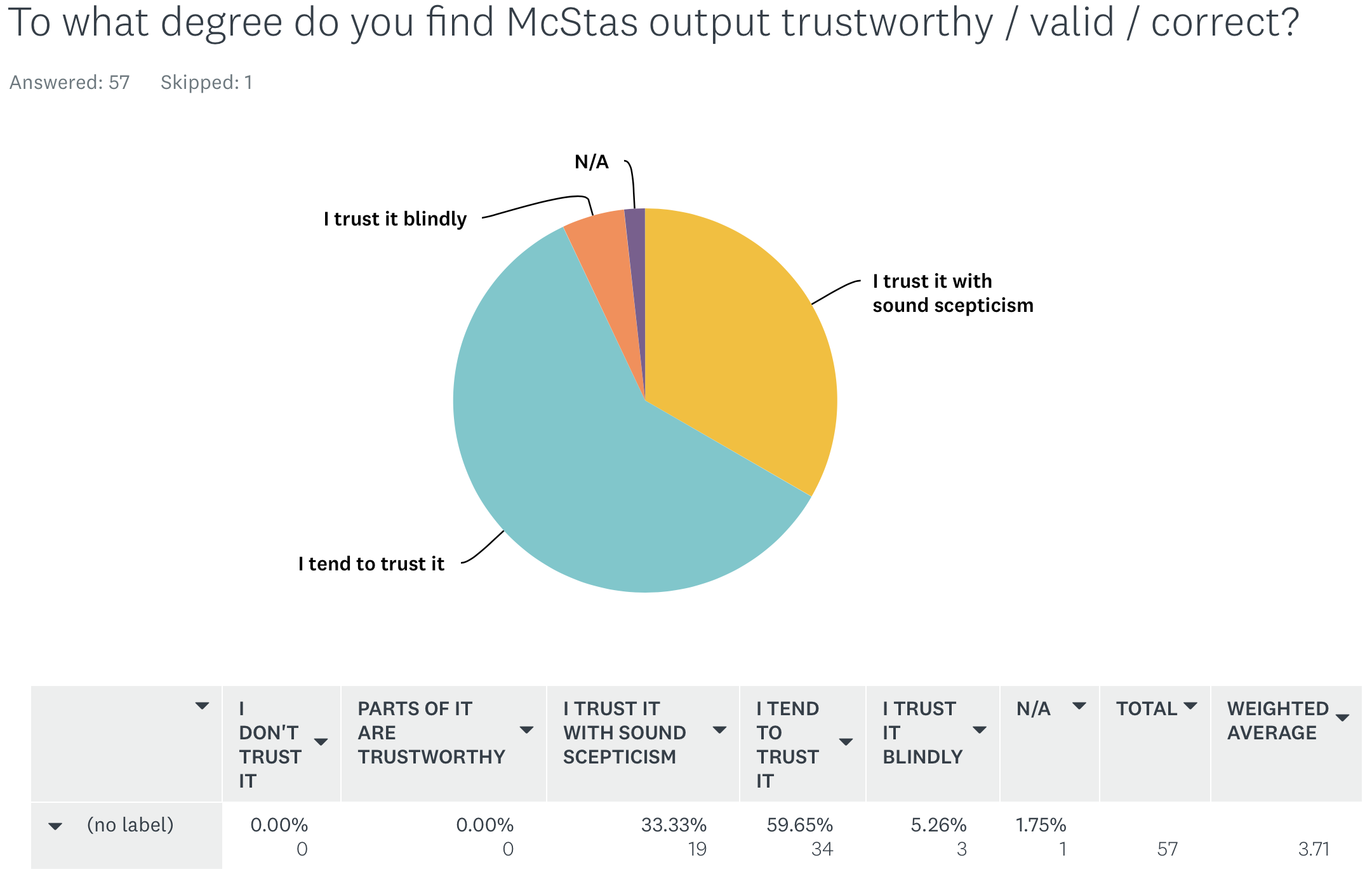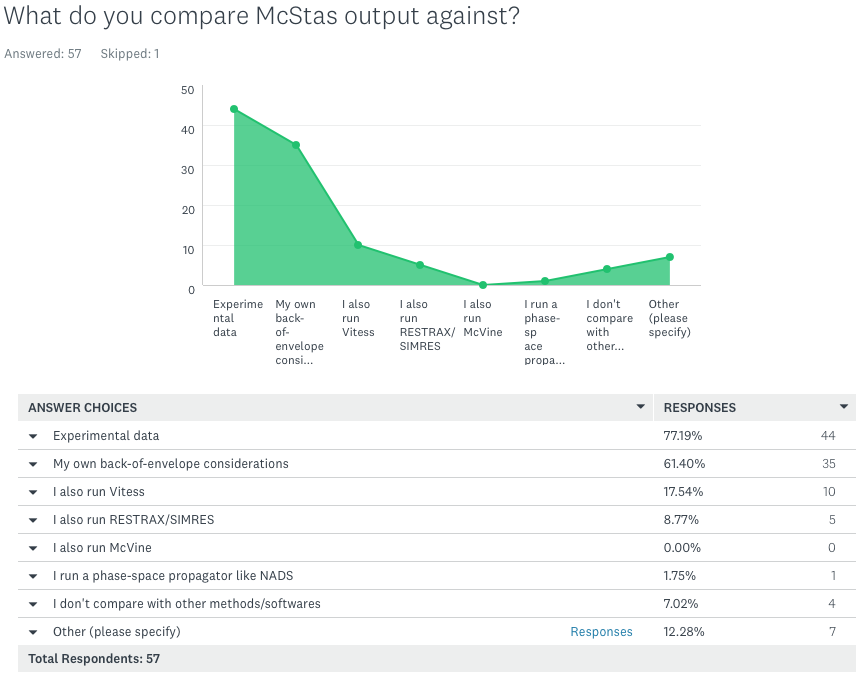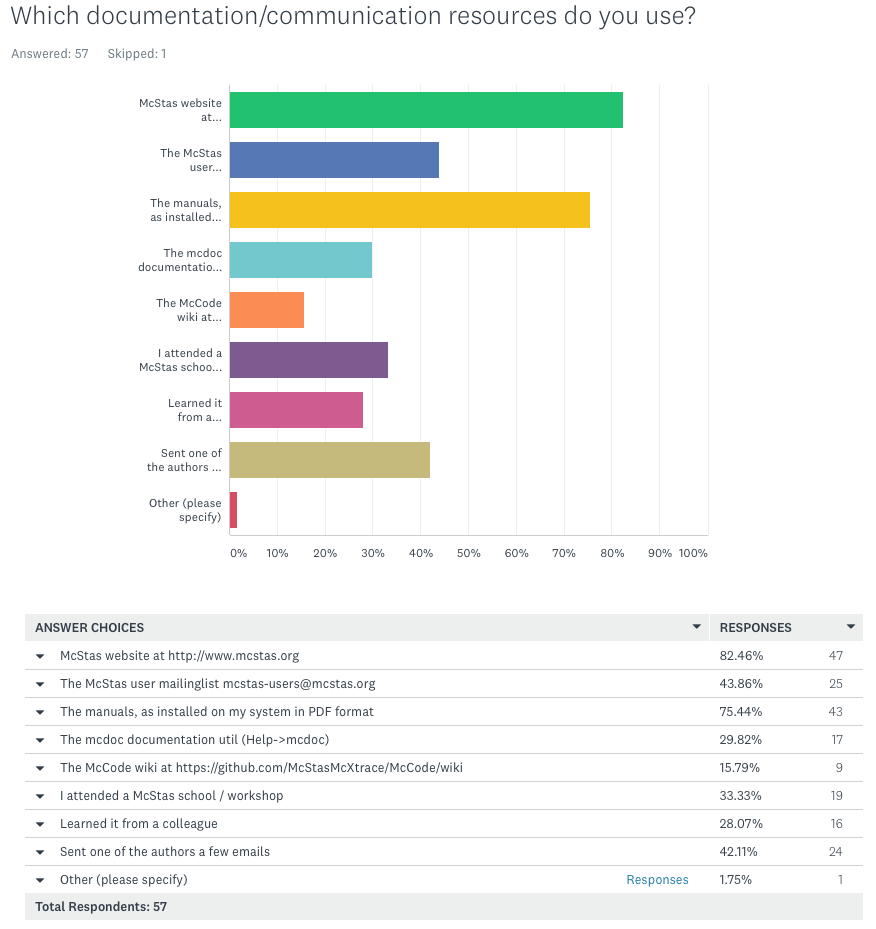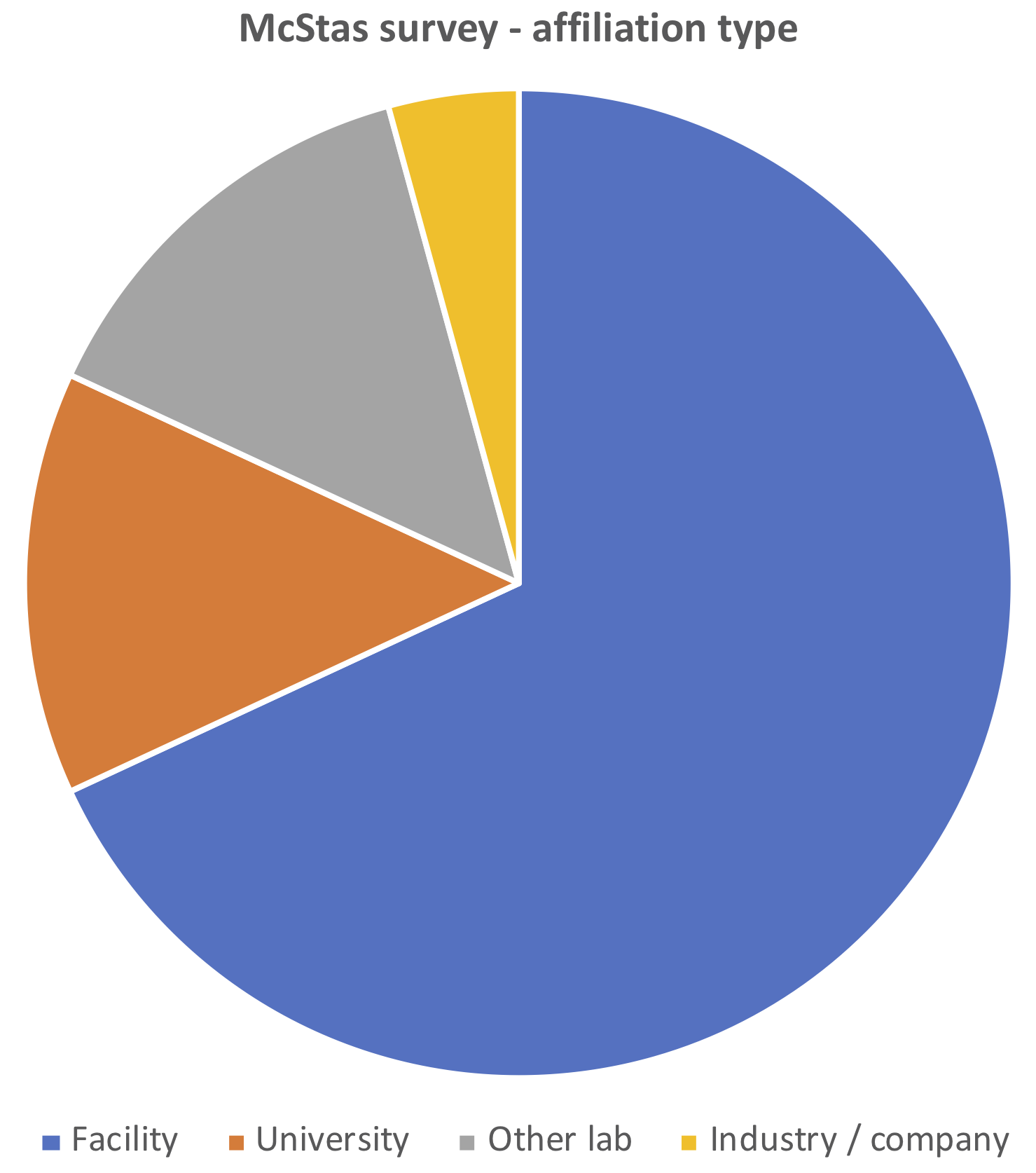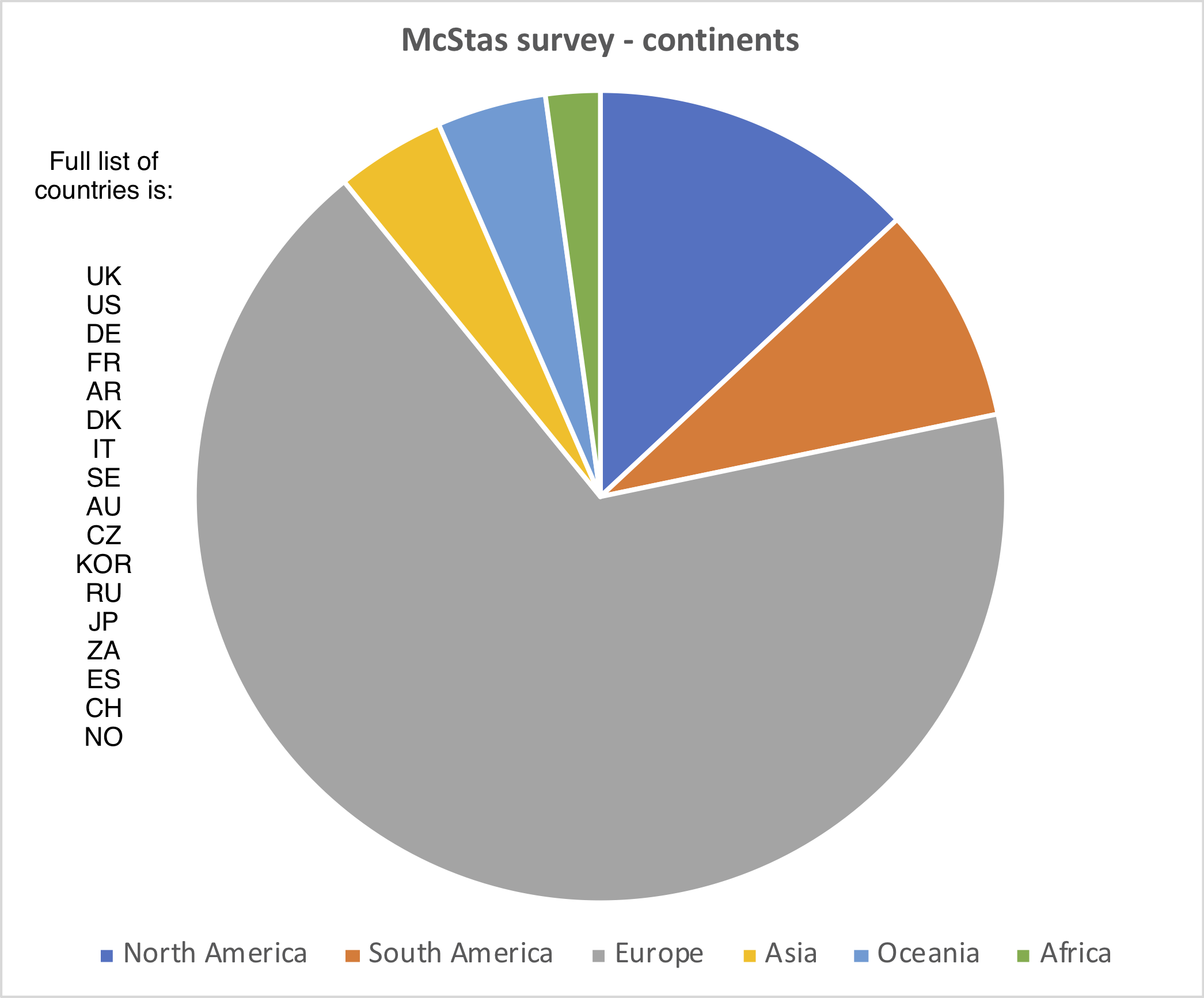Result summary for the 2018 McStas user survey
[ Questions asked
| Q1
| Q2
| Q3
| Q4
| Q5
| Q6
| Q7
| Q8
| Q9
| Q10
| Conclusions ]
McStas website
| Open GitHub issues ]
In the period from November 6th-December 3rd 2018 a survey among the McStas users was carried out through SurveyMonkey .
The survey was disseminated through these channels:
The ten questions posed were these:
Which version of McStas are you running?
Response options: Results: Responses under "Other":
Not really used McStas this year.
Conclusion: McStas users tend to upgrade to the latest release.
What OS(es)/systems do you run McStas on?
Response options: Results: Responses under "Other"
Windows 8
Conclusion: Linux is by a large margin the most used platform, followed by Windows 10 and macOS.
Do you generally find McStas easy to install and use?
Response options: Results: Responses under "Other":
Mcstas: ok, Mantid: ok, nexus libraries: not ok
McStas is easy. Adding NeXuS support is not. Not really your fault
A lot better than earlier Versions!
Needed help - could be a user problem rather than software though...
Conclusion: McStas are generally happy about the installation and use of the package. Very few people have issues with installation.
Which set of (gui/plotting) tools are you mainly using?
Response options: Results: Comments:
Private Python scripts that process Monitor outputs.
A combination. Pgplot and python for plotting with MATLAB for trace view
command line to run it, Mantid to analyze it
I have written a basic set of interfacing tools to run commands from Matlab, and to then read the simulation results and plot them using the graphics tools in the Horace neutron scattering software package
I use Igor Pro to read and plot the ASCII output.
Conclusion: The most used tool set is the default Python version, default since v. 2.1.
How well does the McStas support work?
Response options: Results: Comments:
A lot of the components have inadequate documentation and inputs sometimes must be provided in strange ways that require user calculations, but those calculation steps aren't explicitly given, which introduces guesswork and room for error. Furthermore the input language is frustrating. Something as simple as making a variable for the "m" value of a curved guide seems impossible because the interpreter doesn't understand variables inside {...} lists. I have a dozen more examples like this.
I don't understand the question
The response time and rate on the mailing list are excellent!
Conclusion: McStas users seem very satisfied with the user support.
To what degree do you find McStas output trustworthy / valid / correct?
Response options: Results: Comments:
We are presently installing guides and my calculations will soon be put to the test.
If I doubt, then I check the components source code.
We've found some bugs in components over the years but we have resolved them
The effort to validate and benchmark is extensive, and results can be mostly trusted, but I have seen specific issues that were not errors (more like "uncommented features") that affected the interpretation of results.
Conclusion: McStas users tend to trust McStas to large extent. But please don't trust it blindly!!
What do you compare McStas output against?
Response options: Results: Responses under "Other"
My own 'older' raytracing code
Analytic calculations
Theoretical calculation whenever possible.
Theoretical formulas to check component behavior (monochromator curvature, Caglioti's fwhm formula for a 2-axis diffractometer)
Ken Andersen's mc code
MCNPX (inhouse version with guides, single-crystal scattering, etc.)
analytical calculations
Conclusion: McStas users mostly compare with experimental data or analytic / back of envelope calculations.
Which documentation/communication resources do you use?
Response options: Results: Comments:
all of the above
Conclusion: McStas users have widespread knowledge of all documentation resources - but we should probably disseminate the wiki further.
What else to improve or add? (New features, support for new technology, better support, anything we didn't address in the survey?)
Responses Conclusion: The individual suggestions/questions/comments/... will be answered through individual GitHub issues .
Where do you work? (Institution name/type and Country)
Results: Conclusion: McStas is used on all continents that have / are planning neutron scattering infrastructure. Users are mostly based at these facilities, but also at other research labs or universities.
Conclusion summary:
Q1: McStas users tend to upgrade to the latest release.
Q2: Linux is by a large margin the most used platform, followed by Windows 10 and macOS.
Q3: McStas are generally happy about the installation and use of the package. Very few people have issues with installation.
Q4: The most used tool set is the default Python version, default since v. 2.1.
Q5: McStas users seem very satisfied with the user support.
Q6: McStas users tend to trust McStas to large extent. But please don't trust it blindly!!
Q7: McStas users mostly compare with experimental data or analytic / back of envelope calculations.
Q8: McStas users have widespread knowledge of all documentation resources - but we should probably disseminate the wiki further.
Q9: The individual suggestions/questions/comments/... will be answered through individual GitHub issues .
Q10: McStas is used on all continents that have / are planning neutron scattering infrastructure. Users are mostly based at these facilities, but also at other research labs or universities.
Peter Willendrup <pkwi@fysik.dtu.dk > / January 2019
 Summary report for the 2018 McStas user survey
Summary report for the 2018 McStas user survey 





